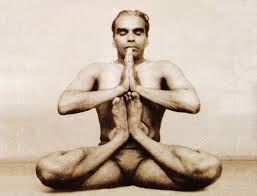
Yoga: proceeding step by step
Yoga practice proceeds not just linearly, so that we experience gains over the previous day’s practice, but also in a spiral-like fashion, so that each component deepens our understanding of the entirety of Yoga. The aspiring yoga practitioners start by making a firm commitment to the ethical living principles of Yama and Niyama, preparing to deepen into the sadhana through two connected practices: aasana, or postures, and pranayama, or regulating and shaping subtle energy flows as it manifests through the breath.
The interconnected body-mind
One of the more surprising beliefs of ancient cultures was that mind and body are interconnected – putting the limbs of our body in certain arrangements is more conducive to certain activities of the mind. This is called asana, literally, sitting, but used in the sense of a pose or posture that is held. Looking at the very wide variety of Yoga postures that today seem to indicate the entirety of Yoga, it is hard to believe that Maharshi Patanjali himself attached very little importance to asana. He states a simple sentence, “sthiram sukham aasanam“, that is, the pose that is stable and pleasing is called asana.
Asana, the meditation pose
It is important to remind ourselves that Yoga is essentially a Vaidik darshan: a philosophy, a sadhana that is aimed at manifesting enlightenment in our life. To that end, meditation is crucial, and therefore, the ability to sit for long hours without moving, as Valmiki and the Buddha sat for days and years on end. In order to achieve that, it was important to prepare the body, as well as to discover the pose that would allow practitioners to sit unmoving for hours. This was the sole aim of asana – to liberate the mind from the shackles of our physical form in order to contemplate the infinite. Maharshi Patanjali states: “Asana can be perfected through giving up concerted effort, and through contemplating the Infinite. The asana perfected in this way leads to a state of perfect calmness free from disturbance of polarities”. Thus even at this beginner’s stage, the sutras clarify that asana is a means to meditation, and needs to be effortless. When practiced along with contemplation of the divine, such an asana leads to a quiet mind that remains undisturbed by the opposite pairs of happiness and misery, pleasure and pain, and so on.
Pranayama, the gentle breath
While asana practice is of the physical body, calming it down in order to let us forget it, pranayama practice is of the breath, allowing us to slow our breathing down in order to further calm the body and mind. The sutras say, “The mind is also calmed by regulating the breath, and slowing it down”. Note again the emphasis: it is to slow down the mind. The breath can be controlled directly, by counting, or by observing one’s pulse or heartbeats, or through focusing one’s concentration on a particular spot of the body. However, the “highest” pranayama is the one where breathing tends to become so slow and subtle as to fall below our awareness: we seem to stop breathing, which is when we realize the flow of “prana”, the subtle life force that underlies breath. Just as asana when perfected is stable and comfortable, and calms the mind, in the same way pranayama when perfected makes the breath infinitely subtle and smooth, again calming the mind.
Yoga: proceeding from effort to effortlessness
When the yoga practitioner can rest in this natural pranayama of very subtle, smooth breathing, the sutras say, mysteriously, “the veil covering the light is thinned”. What this light is, and what its source could be, is left for later. However, it is stated that the repeated experience of this subtle prana gradually destroys our kleshas, a term that literally means shaded or coloured, but understood to mean psychological imprints and tendencies.
These two steps that are still largely physiological in nature will prepare the Yoga practitioner for the inner stages of sadhana, putting effort into going within oneself.
































Nice post TFI…